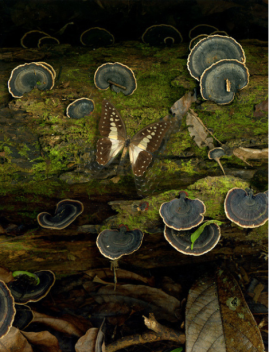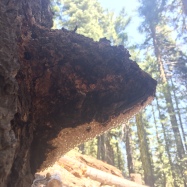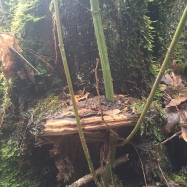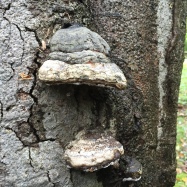Take a moment to forget.
Forget about the idea that mushrooms have chemicals that have pharmacological potential. Forget that you want to learn about the mushrooms so that you can ‘use’ them.
Just for a moment, let’s see the mushrooms as their own organism.
Their own organism with all of their chemicals not for the human system, but for the fungal system.
Every constituent that we wish to extract and isolate and identify has an important role within the living mushroom, and a role within the entire ecosystem.
Let’s explore these compounds and their functions within the mushroom before exploring their functions and relations within the human system.
Remember, a human is not their cholesterol, a human is not their pheromones, a human is not their amino acids. A human is a synergistic organism made up of thousands of molecules and cells all working together. It is impossible to understand who a human is from just analyzing one of these molecules.
When we look at the mushroom through the lens of its parts, keep in mind it is the synergism between these parts that makes the organism, not the isolated constituents.
The purpose of this writing is to first investigate major myco-constituents that have been researched for their medicinal value and understand their innate role in the fungal organism. After delving into the mushrooms on a cellular level I’ll discuss how these constituents interact with the human system. We did after all evolve with the mushrooms, we just work so beautifully together. Through understanding the innate role of these compounds and where they are within the mushroom organism, we gain insight into the best ways to extract these compounds to support our own physiology. Specific constituents that will be discussed: Polysaccharides, volatile compounds (Alcohols, monoterpenes, sesquiterpenes, aldehydes, ketones), triterpenes, ergosterol, phenolic compounds, and fatty acids.
The Fungal Cell
The cell wall is an exquisite and imperative structure in all organisms. The cell wall role in fungi is similar to the role of the cell membrane in humans – it is dynamic in controlling the shape and protecting the organism from the environment. The cell well is made up of compounds involved in morphogenesis, reproduction, cell-cell and cell-matrix interaction. The fungal cell is rigid as it is made up of one of the hardest substances, chitin. Although rigid, it must also be complex to allow for budding, growth and adaptation to environmental stress. The fungal cell wall is composed of multidimensional, communicating polysaccharides including chitin and glucans. (Taborda)
Polysaccharides
– Many simple sugar molecules attached to one another, referred to as glucans when it is glucose molecules-

In the Mushroom
These chains of sugars may be extracellular (outside the cell wall), may be associated with the cell wall and membrane, or may be intracellular. Extracellular polysaccharide function is unclear, pullulan a polysaccharide similar to glycogen and mycodextran are alpha linked glucans that are extracellular. From what I could gather, the function of these may be as storage reserves. Beta 1,3 and beta 1,6 glucans are also sometimes found on the outside of the cell, but are most often important components of the cell wall itself. (Griffin) The major role of polysaccharides is in providing cell wall structure. As Basidiomycota (fungi with fruiting bodies) grow and mature fruiting bodies, the total polysaccharide levels increase. (Friedman)
With this knowledge about the role of these compounds as structural support and barrier to the fungal cell we can understand the role within the human organism.
In the Human
The polysaccharides act in the human in an analogous way as they act in the fungal cell. They support the human cells in responding to environmental stressors within the human terrain.
Polysaccharides play a number of functions in the human system. Once ingested, these compounds move through the GI, coming into contact to mucous membranes all the way down through the inner tube from mouth to anus. The mucous membranes have lymphoid tissue called gut associated lymphoid tissue (GALT) that contains immune cells called macrophages. These macrophages, or big eaters, are an important part of our innate immune system. These immune cells have specific receptors for beta-glucans, Dectin-1 and TLR2. Once the beta- glucans come into contact with them, there are chemical messengers called cytokines that are stimulated. Specifically, IL-12 and IFN-y. These cytokines are important in stimulating Natural killer cells, Cytotoxic T cells and TH1 cells. Once these cells are stimulated they target viruses and cancer cells. (guggenhein)
Polysaccharides also function as soluble fiber. When they enter the gut, they slow the release of glucose into the blood stream, acting as hypoglycemic compounds. They also help to decrease cholesterol through binding bile acids. When bile acids end up in the soluble fiber, they are pooped out and then the body will use cholesterol to make more, rather than recycling the bile acids. Along with binding bile acids, they also prevent absorption of cholesterol from food in the GI, further lowering serum cholesterol. These polysaccharides are also beneficial in controlling blood sugar. Polysaccharides inhibit the enzyme, alpha-glucosidase, this enzyme is known to induce after meal hyperglycemia. Along with inhibiting this enzyme, polysaccharides have also been shown to upregulate the GLUT 4, insulin-response glucose transporter, while down regulating NFkappa-B, a nuclear transcription factor that controls regulation of inflammation. (friedman, shamtsyan)
Polysaccharides as antioxidants: Polysaccharides increase activities of liver oxidative enzymes, catalase, glutathione peroxidase, and superoxide dismutase and increase glutathione and malondialdehyde levels. This is all to say that these compounds support our innate antioxidant systems supporting the human in relieving oxidative stress and free radical damage.
Polysaccharides as prebiotics: The oligosaccharides and polysaccharides contained in mushrooms are consumed by Bifidobacterium and Lactobacilli, two important bacteria in a healthy microbiome. Through supporting a healthy gut microbiome, this can also be helpful with asthma, allergies, anxiety and even depression.
Extraction method:
Hot water – 100 degrees C for at least 2 hours
Volatiles Compounds and Triterpenes
Low molecular weight, carbon based compounds that vaporize at about 20 degrees Celsius. Include: Alcohols, monoterpenes, sesquiterpenes, aldehydes, and ketones
Triterpenes have 30 carbons and are too heavy to be volatile, but I put them here since they are made in the same pathway as monoterpenes and sesquiterpenes.

In the Mushroom
These volatile compounds are derived from primary and secondary metabolism pathways; they diffuse through the atmosphere as “infochemicals”
These chemicals function as attractants and deterrents to insects and other invertebrates. Fungal volatiles have important properties as pheromones and defense. Some of these compounds are an efficient way of defending against fungal feeders. Octanol, often called mushroom alcohol, is an alcohol that deters banana slugs from eating mushrooms while also serving as an attractant for fungus eating beetles. Amusingly, octanol from human skin serves as a host odor cue that attracts blood sucking insects. Trametes versicolor is an example of a polypore mushroom that produces sesquiterpenes: specifically, cardinene, beta guiaene, isoledene and gamma patchoulene that attract fungivorous beetles. (morath,Rosecke) Through attracting these insects the mushrooms are better able to spread their spores and inoculate nearby substrate. A good way to make more of themselves!
Monoterpenes, sesquiterpenes and triterpenes are all compounds in mushrooms that have a cholesterol backbone. (The chemical structure looks similar to cholesterol)
Triterpenes are the heaviest of the three since they have 30 carbons and the others have 10 and 15 carbons respectively. Within the mushroom cell, triterpenes are converted into various metabolites including sterols, steroids, and saponins. They are produced via a pathway called the mevalonate pathway with a starting molecule called acetyl-coa. Animals have a very similar pathway that leads to cholesterol synthesis! This pathway in fungi also leads to ergosterol (a precursor to vitamin D2) which plays the same role that cholesterol plays in the human cell. It is a major component of the plasma cell membrane in fungi, important for membrane permeability.
Cytochrome p450 is important in gene expression and triterpenoid production. There is significantly more CYP450 during the transition from primordia to fruiting bodies, correlating with a higher triterpene content in the mushroom fruiting bodies. – developmental stage of fungal growth plays an important role in the regulation of secondary metabolite genes. (rep NP) (Schmidt-dannert, Schrader)
In the Human
Volatile compounds are very low molecular weight and cross easily through barriers and membranes. It is for this reason that essential oils are so readily absorbed through the skin and mucous membranes. Some volatile compounds can be neurotoxic for this reason, and some can be neuroprotective. There is research now exploring the role of octanol as an antiseizure agent. (Manjarrez-Marmolejo, chang, jahromi) Octanol reduced seizure induction and seizure discharges when it was applied directly to the epileptic focus in the somatosensory cortex. Additionally, it has been reported that administration of octanol significantly reduces the frequency and amplitude of epileptiform spikes, as well as the epileptic behavioral score induced by the administration of penicillin. (Manjarrez).
Some fungal sesquiterpenes have also been shown to inhibit TGF-b, decreasing kidney fibrosis in late stage kidney disease. Triterpenes are major compounds of interest in cancer research. Triterpenes have been shown to be directly cytotoxic to many cancer cell lines. (Rios, Grienke, Bhattarai, Ren, Jin, , Zhu) Triterpenes also have specific antiviral activity, inhibiting an enzyme, neuraminidase, which is important for viruses to be able to leave one cell to enter another. (Teplyakova, Gao) Triterpene compounds have been shown to be very beneficial in treatment of hypersensitivity reactions. Hypersensitivity reactions include allergy, asthma, dermatitis, and rhinitis. Triterpenes inhibit histamine release from mast cells – less histamine will result in less of a reaction. These can also be used in treatment of inflammatory reactions caused by insect stings and bites. (Rios)
Extraction Method
Volatile compounds need to be extracted from fresh mushrooms and will escape into the atmosphere with heat. They are alcohol and fat soluble. Best to do a cold ethanol extraction for volatile compounds. 24 hours is sufficient.
Triterpenes will not volatilize and are also fat and alcohol soluble. There are terpenes within the cell, and so it is best to break the chitin cell wall first with a water decoction, before proceeding with ethanol to extract the triterpenes. A triple extraction method will be provided at the end of this post.
Fatty acids
– Molecules that are long chains of lipid-carboxylic acid found in fats and oils and in cell membranes as a component of phospholipids and glycolipids –
In the Mushroom
Principal lipids in mushrooms are palmitic and linoleic acid. The fruiting body and pileus (cap) contains more linoleic acid and the stipe contains for oleic acid. The linoleic acid plays a role in fungal reproductive mechanisms. Trametes versicolor contains more short chain fatty acids – octanoic, decanoic and lauric acid. (Summer) Fungal membranes contain large quantities of free fatty acids, specifically glycerolipids and acylglycerols. These fatty acids occur in fungi as the major constituents of oil droplets suspended in mycelial and spore cytoplasm. They are also minor constituents of membranes and cell walls. Their primary function is storage material. Phophoglycerides are formed from a combination of fatty acids and are found primarily in the plasma membrane of cellular organelles, where they occur as complexes with proteins.
In the Human
Short chain fatty acids found in Trametes species modifies human fecal microbiota composition, increasing healthy bacteria – Bifidiobacteria and Lactobacillus while decreasing E.coli. (Yu) Short chain fatty acids also lower the intestinal pH, inhibiting growth of microbial pathogens (Plummer)
These fatty acid compounds also have antioxidant activities found to be as effective as alpha-tocopherol (Vit E) while also showing significant antimicrobial and anti-fungal activity. (Younis)
Extraction method:
Fat and alcohol soluble
Phenolic compounds
-The term ‘phenolic’ or ‘polyphenol’ can be defined chemically as a substance which possesses an aromatic ring bearing one or more hydroxy substituents, including functional derivatives (esters, methyl ethers, glycosides etc.)- Commonly known phenolic compounds include: bioflavonoids and proanthocyanidins
In the Mushroom
The phenolic compounds in mushrooms are secondary metabolites derived from intermediates of the shikimic acid pathway, the primary role of which is to provide the essential aromatic amino acids phenylananine, tyrosine and tryptophan. The intermediates of the shikimic acid pathway are precursors of aromatic compounds, including phenolic compounds. The biosynthesis of these compounds has demonstrated that they possess enzymes such as ammonia-lyases that convert phenalynine and tyrosine to cinnamic acids. These compounds represent the building blocks for pigments in mushrooms. The phenolic compound hispolon is an example of a yellow pigment in mushrooms. (Velisek)
In the Human
Phenolic compounds act as powerful antioxidants in the human organism. These compounds help to reduce oxidative stress through their own free radical scavenging activity as well as through stimulating the innate human antioxidant systems. (Geng) Phenolic compounds in mushrooms have also been shown to inhibit alpha-glucosidase in rats and significantly help with diabetic complications caused by this compound. A specific phenolic compound, hispolon, found in Phellinus species has been shown to have analgesic and anti-inflammatory effects as well as inhibits the growth of human cancer cells via the inhibition of the cytokine, TGF-beta. Hispolon also activates caspase, an important enzyme that induces cancer cell death. (Govindappa, Huang, Hong, Chang, Wu, Hsieh)
Extraction Method:
Ethanol or Water depending on how polar the phenolic compound is, best to do a triple extraction so you are sure to get them all.
Triple Extraction
The best way to get all of these compounds in one extract is to do a triple extraction method. The first part of the triple extraction is an overnight ethanol extraction. I use 95% ETOH and poor it over finely chopped/shredded fresh mushroom. Let this sit for 24-48 hours. Press the ETOH from the mushroom material and set aside (ETOH extract #1). Next, place the mushrooms from the original extraction into a crockpot or soup pot, cover with water and simmer for 2-12 hrs (The aqueous extract). Next, place these mushrooms and aqueous extract into a jar and leave the jar 1/3 empty. Fill the last 1/3 of the jar with the ETOH extract #1. Let sit (macerate) for a few weeks, shaking and loving daily. Press out mushrooms (the marc) from ETOH/Aqueous solvent (menstruum). Now you have your triple extraction – containing the volatile compounds, the polysaccharides, the triterpenes, phenolic compounds, and fatty acids.
Work Cited
- Bhattarai G, Lee Y-H, Lee N-H, et al. Fomitoside-K from Fomitopsis nigra Induces Apoptosis of Human Oral Squamous Cell Carcinomas (YD-10B) via Mitochondrial Signaling Pathway. Biol Pharm Bull. 2012;35(10):1711-1719. doi:10.1248/bpb.12-00297.
- Chang H, Sheu M, Yang C, et al. Analgesic Effects and the Mechanisms of Anti-Inflammation of Hispolon in Mice. 2011;2011. doi:10.1093/ecam/nep027.
- Chang WP, Wu JJS, Shyu BC. Thalamic Modulation of Cingulate Seizure Activity Via the Regulation of Gap Junctions in Mice Thalamocingulate Slice. PLoS One. 2013;8(5). doi:10.1371/journal.pone.0062952.
- Friedman M. Mushroom Polysaccharides : Chemistry and. 2016. doi:10.3390/foods5040080.
- Gao L, Sun Y, Si J, et al. Cryptoporus volvatus extract inhibits influenza virus replication in vitro and in vivo. PLoS One. 2014;9(12). doi:10.1371/journal.pone.0113604.
- Geng P, Siu KC, Wang Z, Wu JY. Antifatigue Functions and Mechanisms of Edible and Medicinal Mushrooms. Biomed Res Int. 2017;2017. doi:10.1155/2017/9648496.
- Grienke U, Kaserer T, Pfluger F, et al. Accessing biological actions of Ganoderma secondary metabolites by in silico profiling. Phytochemistry. 2015;114:114-124. doi:10.1016/j.phytochem.2014.10.010.
- Griffin, David H. (State University Of New York, U. Usa. Fungal Physiology. John Wiley And Sons, 1996.
- Guggenheim AG, Wright KM, Zwickey HL. Immune Modulation From Five Major Mushrooms: Application to Integrative Oncology. Integr Med. 2014;13(1):32-44
- Hong D, Park MINJU, Jang EUNH, Jung BOM, Kim NAMJ, Kim JHO. Hispolon as an inhibitor of TGF ‑ β ‑ induced epithelial ‑ mesenchymal transition in human epithelial cancer cells by co ‑ regulation of TGF ‑ β ‑ Snail / Twist axis. 2017:4866-4872. doi:10.3892/ol.2017.6789.
- Hsieh M, Chien S, Chou Y, Chen C, Chen J, Chen M. Phytomedicine Hispolon from Phellinus linteus possesses mediate caspases activation and induces human nasopharyngeal carcinomas cells apoptosis. Eur J Integr Med. 2014;21(12):1746-1752. doi:10.1016/j.phymed.2014.07.013.
- Huang G, Hsieh W, Chang H, Huang S, Lin Y, Kuo Y. r -Glucosidase and Aldose Reductase Inhibitory Activities from the Fruiting Body of Phellinus merrillii. 2011:5702-5706. doi:10.1021/jf2003943.
- Jahromi SS, Wentlandt K, Piran S, Carlen PL. Anticonvulsant actions of gap junctional blockers in an in vitro seizure model. J Neurophysiol. 2002;88(4):1893. doi:10.1152/jn.00801.2001.
- Jin X, Ruiz Beguerie J, Sze DM-Y, Chan GCF. Ganoderma lucidum (Reishi mushroom) for cancer treatment. Cochrane database Syst Rev. 2016;4:CD007731. doi:10.1002/14651858.CD007731.pub3.
- Manjarrez-Marmolejo J F-PJ. Gap Junction Blockers: An Overview of their Effects on Induced Seizures in Animal Models. Curr Neuropharmacol. 2016;14(7):759-771. doi:10.2174/1570159X14666160603115942.
- Melappa G, Roshan A, Nithi C, Mohummed TS, – C, Poojari CC. Phytochemical analysis and in vitro antioxidant, antimicrobial, anti-inflammatory and cytotoxicity activities of wood rotting fungi, Trametes ochracea. Pharmacogn J. 2015;7(2):136-146. doi:10.5530/pj.2015.2.8.
- Morath SU, Hung R, Bennett JW. Fungal volatile organic compounds: A review with emphasis on their biotechnological potential. Fungal Biol Rev. 2012;26(2-3):73-83. doi:10.1016/j.fbr.2012.07.001.
- Plummer NT. Part 2: Treatments for Chronic Gastrointestinal Disease and Gut Dysbiosis. 2015;14(I):25-33.
- Ren G, Liu XY, Zhu HK, Yang SZ, Fu CX. Evaluation of cytotoxic activities of some medicinal polypore fungi from China. Fitoterapia. 2006;77(5):408-410. doi:10.1016/j.fitote.2006.05.004.
- Rep NP. Traversing the fungal terpenome. 2015;31(10):1449-1473. doi:10.1039/c4np00075g.Traversing.
- Ríos JL. Effects of triterpenes on the immune system. J Ethnopharmacol. 2010;128(1):1-14 doi:10.1016/j.jep.2009.12.045.
- Rösecke J, Pietsch M, König WA. Volatile constituents of wood-rotting basidiomycetes. Phytochemistry. 2000;54(8):747-750. doi:10.1016/S0031-9422(00)00138-2.
- Schmidt-dannert C. Biosynthesis of Terpenoid Natural Products in Fungi. 2015;(November 2014):19-61. doi:10.1007/10.
- SCHRADER, JENS. BIOTECHNOLOGY OF ISOPRENOIDS. SPRINGER INTERNATIONAL PU, 2016.
- Shamtsyan M, Antontceva E, Panchenko A, Petrischev N. HYPERLIPIDEMIC AND HYPOCHOLESTEROLIC ACTION OF SUBMERGE CULTURED MUSHROOMS.
- Sumner JL. The fatty acid composition of basidiomycetes. 2012;8643(1973). doi:10.1080/0028825X.1973.10430293.
- Taborda CP, Janeiro R De. GLYCOCONJUGATES AND POLYSACCHARIDES OF FUNGAL CELL WALL AND ACTIVATION. 2008:195-208.
- Teng F, Bito T, Takenaka S, Yabuta Y, Watanabe F. Vitamin B 12 [ c ‑ lactone], a Biologically Inactive Corrinoid Compound, Occurs in Cultured and Dried Lion ’ s Mane Mushroom ( Hericium erinaceus ) Fruiting Bodies. 2014. doi:10.1021/jf404463v.
- Teplyakova T V., Psurtseva N V., Kosogova TA, Mazurkova NA, Khanin VA, Vlasenko VA. Antiviral Activity of Polyporoid Mushrooms (Higher Basidiomycetes) from Altai Mountains (Russia). Int J Med Mushrooms. 2012;14(1):37-45. doi:10.1615/IntJMedMushr.v14.i1.40.
- Velíšek J, Cejpek K. Pigments of Higher Fungi : A Review. 2011;29(2):87-102.
- Wu Q, Kang Y, Zhang H, Wang H, Liu Y, Wang J. Biochemical and Biophysical Research Communications The anticancer effects of hispolon on lung cancer cells. Biochem Biophys Res Commun. 2014;453(3):385-391. doi:10.1016/j.bbrc.2014.09.098.
- Younis AM, Wu F-S, El Shikh HH. Antimicrobial Activity of Extracts of the Oyster Culinary Medicinal Mushroom Pleurotus ostreatus (Higher Basidiomycetes) and Identification of a New Antimicrobial Compound. Int J Med Mushrooms. 2015;17(6):579-590. doi:10.1615/IntJMedMushrooms.v17.i6.80.
- Yu Z, Liu B, Mukherjee P, Newburg DS. Trametes versicolor Extract Modifies Human Fecal Microbiota Composition In vitro. 2013:107-112. doi:10.1007/s11130-013-0342-4.
- Zhu Q, Bang TH, Ohnuki K, Sawai T, Sawai K, Shimizu K. Inhibition of neuraminidase by Ganoderma triterpenoids and implications for neuraminidase inhibitor design. Sci Rep. 2015;5(AUGUST):13194. doi:10.1038/srep13194.












